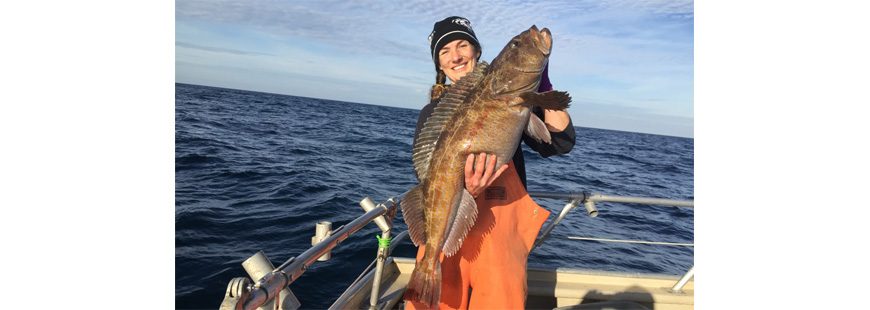Tamara Mautner from Garibaldi Charters with a large lingcod taken from a deep reef out of Garibaldi on October 12, 2016
It’s a day many bottomfishers have been waiting for since the previous fall: the deep reef opener. The deep reef actually opens on October 1st, but in order for this to actually be a good trip, the weather should be nice, calm seas in particular. That’s about all you need, because the fish are there, and they are there in numbers. It’s not just the numbers that inspire bottomfishing anglers to wait so long for this opportunity, it’s the size of these fish; they are whoppers! Is this what ecosystem-based fisheries management looks like? Well, maybe not by definition, but it gives you an idea of what the possibilities are.
One of the benefits of blogging on a weekly basis is the opportunity to learn more about what you’re writing about. Who doesn’t want to do that? You still have to make time, however. In the case of lingcod, I found some interesting facts about lingcod from an Alaska Department of Fish and Game fact sheet on lingcod. I wanted to know how old Tamara’s lingcod was. For a fact sheet, I didn’t find that little tid-bit of information.
What was interesting is that lingcod are actually in the greenling family, so they are not a true cod. I might have found a new reason to catch greenling as anything related to a lingcod must be great tasting too. Experienced anglers will often single out lingcod as their favorite whitefish, even over halibut. It’s a toss-up for me… I can’t seem to get enough of either to satisfy my hunger for fish.
Lingcod also harbor some unusual spawning behaviors, such as the male lingcod watches over the egg mass, while the female goes off on her way (I hope my wife isn’t reading this blog…). Females begin to sexually mature between 3 and 5 years old (about 24 inches in length), while males are ready to reproduce at age 2. After about 4 years, females begin to grow much more rapidly than the males, with one of the largest lingcod ever recorded around 85 pounds. I don’t think I’d want to run across a male that big guarding a nest full of eggs.
The life history, at least the spawning phase of their life history, makes adults and soon-to-be juveniles fairly susceptible to predation. If the males get caught or predated upon while in the process of guarding the egg masses, there is a high probability that the eggs will be destroyed within 48 hours of the exit of the male. It’s a rough life out there.
Lingcod aren’t as long-lived as many species of rockfish. A 20-year old lingcod is an old fish, while some rockfish species live to be over 100 years old. Lingcod are a success story in Oregon. Just when I found out how tasty these creatures were, their numbers were plummeting, and harvest was being severely curtailed. But, with the provisions in the Magnuson-Stevens Act, specifically the part about rebuilding depleted stocks of fish, this species is “back on the table,” in more ways than one.
Now, about this deep-reef thing… the deep-reef fishery is only open from October 1st – April 1st. It’s not a large window, and it’s during the roughest part of the year, when most boats can’t often get out. This strategy has paid dividends, however, and it’s really common sense:
- Fish receive less pressure, enabling them to control the take on a specific population of fish, lingcod in this case;
- It allows most species to grow larger, creating a demand for this species, because everyone wants to catch a big fish! (These trips are very popular with the local charter boat operators);
- By allowing fish to grow larger, they produce more offspring and offspring of higher quality.
These are all elements of ecosystem-based fish management, allowing species of fish to manage themselves instead of active management under a single species regime, the traditional way we have managed stocks of fish.
I can’t say I know all the details of the rebuilding plan for West Coast lingcod, but if you have time to pour through 218 pages, let me know. Certainly cordoning off quality habitat, keeping strict tabs on harvest and admittedly, luck likely played a role in how quick the stocks rebuilt. It would be nice if humans could take all the credit for the quick rebuilding of lingcod stocks, but IMHO, it’s likely we got a short window of opportune ocean conditions that allowed for some productive brood years.
Ecosystem-based fisheries management is a compelling component of a dynamic law that protects our stocks of fish from over-fishing and offers up a solid plan for rebuilding depleted stocks of fish. As you continue to hear about the benefits of the Magnuson-Stevens Act, you’ll agree with other vested fishermen that we need a strong reauthorization to build on our successes and ensure that a productive deep-reef fishery is maintained for generations to come.


